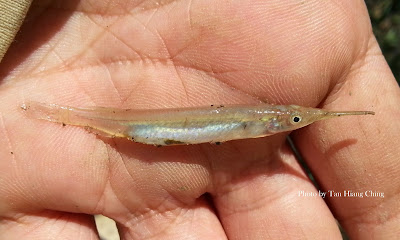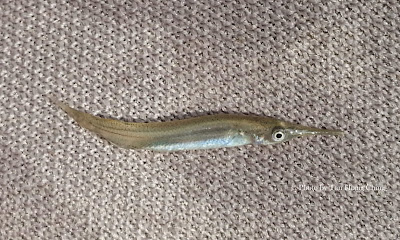Viviparous Halfbeaks
Viviparous halfbeaks belong to the Zenarchopteridae family. Most are small to moderate-sized fish. Similar to Hemiramphidae, they have distinctive jaws with the lower jaw significantly longer than the upper jaw. Zenarchopteridae practice internal fertilization, giving birth to live young. They have external paired olfactory organs with small cone-like papillae, also known as nasal barbels. There are noticeable differences between males and females of the same species.
Viviparous halfbeaks are mainly found in Indo-West Pacific estuarine and freshwater environments and are often seen at the water surface. They primarily feed on small floating larvae and adult insects on the water surface.
The Zenarchopteridae family comprises 5 genera and about 60 species worldwide. Malaysia has approximately 3 genera and 10 species.
Viviparous halfbeaks are mainly found in Indo-West Pacific estuarine and freshwater environments and are often seen at the water surface. They primarily feed on small floating larvae and adult insects on the water surface.
The Zenarchopteridae family comprises 5 genera and about 60 species worldwide. Malaysia has approximately 3 genera and 10 species.
Scientific Name: Dermogenys collettei Meisner, 2001
English Name: Pygmy Halfbeak, Malayan Pygmy Halfbeak
Malay Name | Nama Melayu Malaysia: Ikan Julong, Jolong-jolong
Thai Name | ชื่อสามัญภาษาไทย: ปลาเข็มภาคใต้ (Plā k̄hĕm p̣hākh tı̂)
Local Hokkien: Chui Chiam
Main Identification Features: Long, slender, cylindrical with the lower jaw extended into a long beak. No fleshy tip on the elongated lower jaw. Anal fin originates before dorsal fin.
Size: Maximum total length to about 7 cm.
Habitat and Ecology: Freshwater and brackish waters. Found near the surface of water of river banks. Feeds primarily on larvae and insects. Viviparous, give birth to live young.



English Name: Pygmy Halfbeak, Malayan Pygmy Halfbeak
Malay Name | Nama Melayu Malaysia: Ikan Julong, Jolong-jolong
Thai Name | ชื่อสามัญภาษาไทย: ปลาเข็มภาคใต้ (Plā k̄hĕm p̣hākh tı̂)
Local Hokkien: Chui Chiam
Main Identification Features: Long, slender, cylindrical with the lower jaw extended into a long beak. No fleshy tip on the elongated lower jaw. Anal fin originates before dorsal fin.
Size: Maximum total length to about 7 cm.
Habitat and Ecology: Freshwater and brackish waters. Found near the surface of water of river banks. Feeds primarily on larvae and insects. Viviparous, give birth to live young.


